Shaping sustainable progress
Sustainability Report 2024

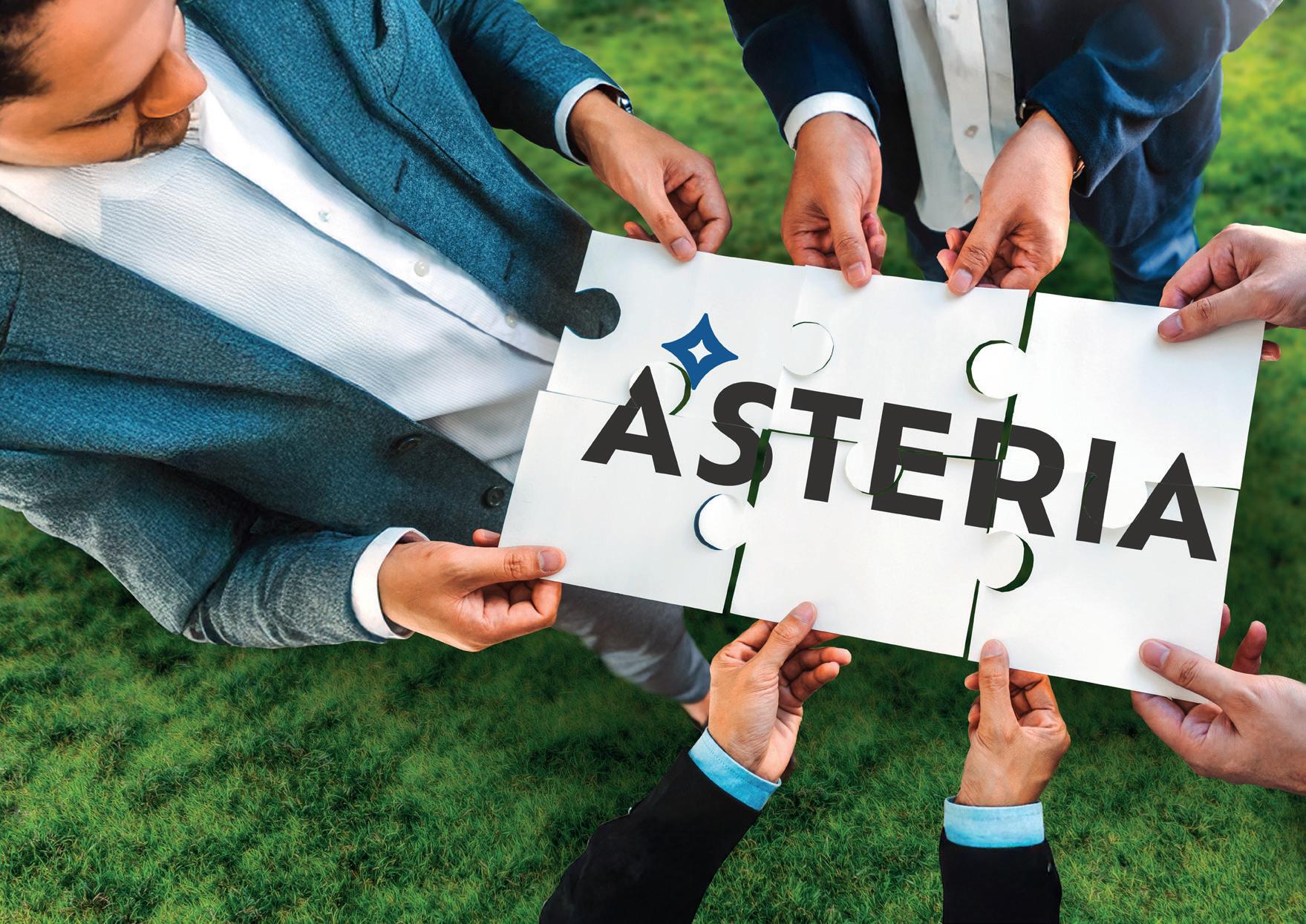

Sustainability Report 2024



This is Asteria Group’s first-time Sustainability Report. Through this report, we want to show how we – in the world of labelling and packaging – are paying more attention to our impact on the environment and society.
Additionally, the report offers stakeholders a chance to observe how our business is evolving and to share their feedback on Asteria Group’s sustainability performance.
The format of this report has been guided by the CSRD regulation and the accompanying ESRS standards.
For further information, we invite you to regularly visit our website and social media: asteriagroup.eu linkedin.com/company/asteriagroup

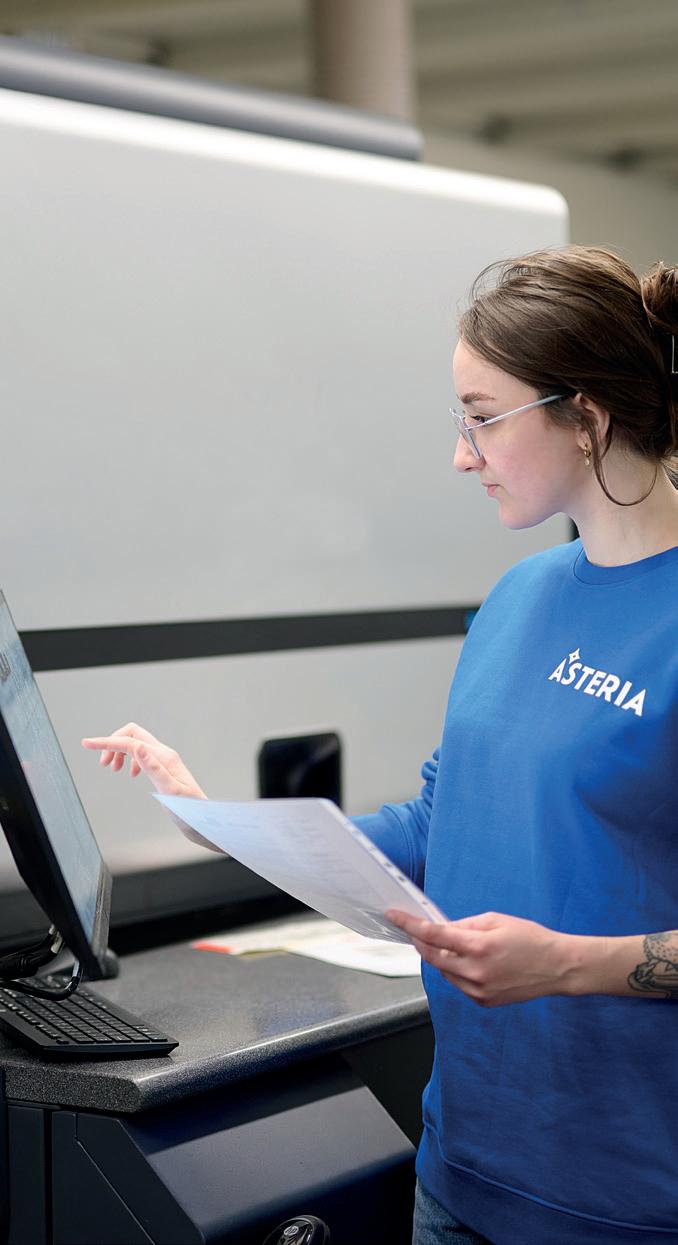
Since 2024, sustainability is firmly embedded in Asteria Group’s core strategy. What began as a response to customer demand and compliance has evolved into a proactively used driver of business growth, cultural integration, and competitive advantage.
CEO Ives Declerck is clear about Asteria’s ambition: “We are committed to being a frontrunner, integrating sustainability into every aspect of our business.”

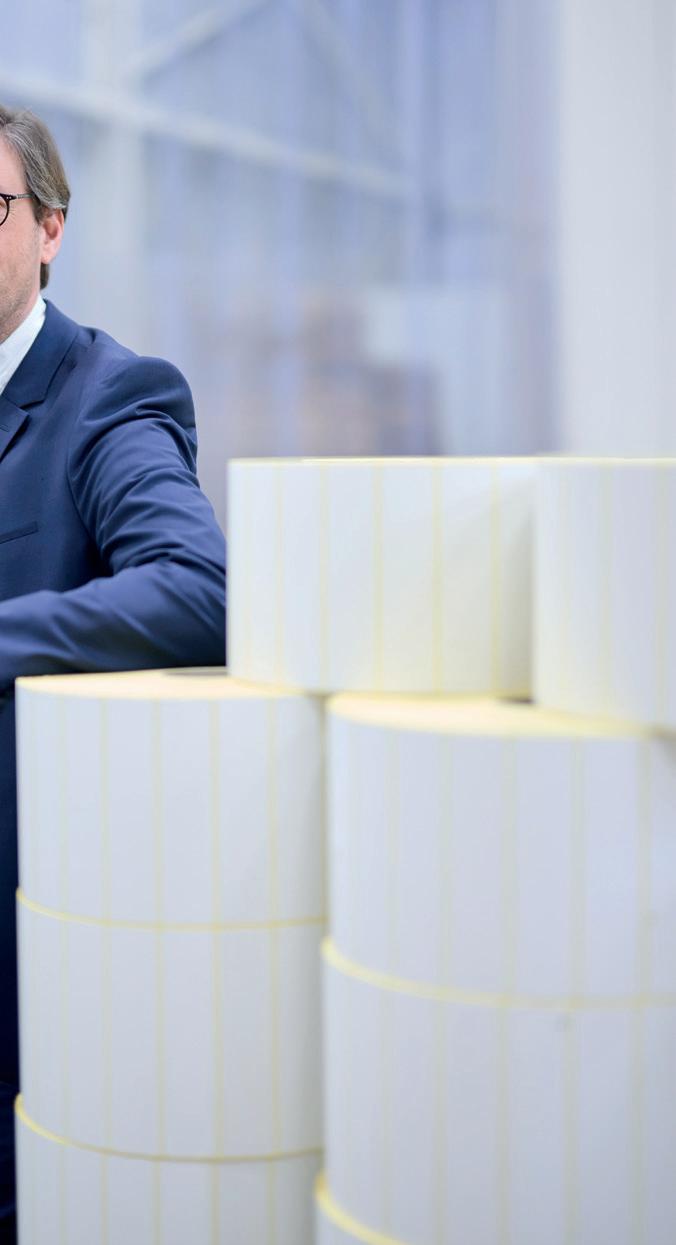
Ives Declerck: “2024 positioned itself as a more stable and normal year after the volatility of the past few years. We faced supply chain disruptions in 2022, which led to over-purchasing and stock accumulation. That impacted our 2023 financials, as customers had excess inventory and reduced their orders. In 2024, we saw a correction, with growth returning and new business coming in, particularly from multinational customers. Financially, we performed in line with our expectations, but what I am most proud of is our ability to attract large, strategic customers. It reinforces Asteria’s reputation as a strong, reliable partner in the industry. Winning these multinational accounts is proof of our capability, presence, and trust.”
“Sustainability is a business imperative. Our journey started with customer demand, particularly from multinationals requiring compliance with the Corporate Sustainability Reporting Directive (CSRD). Meeting legal requirements is a no-brainer, but we see the green transition as an opportunity to differentiate ourselves and drive long-term value. We want to be the frontrunner. This means developing sustainable products, integrating best practices across all our sites, and working closely with suppliers and customers to reduce our environmental impact. The market is moving, and we intend to be ahead of the wave rather than chasing it.”
“Our biggest challenge by far is the scope 3 emissions, which means tackling the environmental footprint of our suppliers and customers. Therefore, we introduced Asteria Sustainable Solutions (A.S.S.) to actively engage with customers and offer sustainable alternatives. Pricing of such materials is still an issue within the wider customer base. That’s why scalability is key. As demand for sustainable materials increases, production costs will come down, making these solutions more attractive. We also negotiate with leading raw material producers to explore bulk purchasing agreements for thinner, recycled, and bio-based materials.”
“Another challenge is the alignment of 35 different Asteria sites, each with their own way of working. Standardising sustainability reporting, ensuring engagement, and integrating a shared culture around sustainability is a complex but crucial task. Regulations like the EU Packaging and Packaging Waste Regulation (PPWR) add another layer of complexity, but they also provide the necessary push to drive industry-wide transformation.”
is Asteria integrating sustainability into its long-term business strategy?
“We are embedding sustainability across all levels of the organisation. A key pillar is customer collaboration. We proactively reach out to a lot of customers to help them achieve their sustainability targets. Rather than just selling products, we position ourselves as strategic partners, offering sustainable solutions that reduce waste and emissions while ensuring cost efficiency – without disrupting their production processes.”
“We see sustainability as a cultural unifier within Asteria. As a group formed through acquisitions, we have 35 companies with different backgrounds. Sustainability helps create a shared purpose and reinforces our identity as one company rather than separate entities.”
“In terms of growth strategy, sustainability is becoming a factor in future acquisitions. While it wasn’t a primary consideration before, we now evaluate potential acquisitions based on their sustainability efforts. In the future, companies with strong sustainability credentials will be more valuable, and we want to be selective about who joins our group.”
How do you ensure sustainability is embedded across Asteria’s 35 sites?
“This is an ongoing process. Sustainability is now a key focus in all meetings, corporate communications, and leadership discussions. Every corporate event, newsletter, and management update reinforces our commitment. Not all sites have the same resources or expertise, so we take a hands-on, supportive approach, guiding teams through reporting requirements and ensuring sustainability is seen as a growth driver, not a burden. The long-term goal is to create a shared sustainability culture, a mindset embedded in our daily operations.”
“More than ever, sustainability will become a decisive factor in winning business. Large corporations are increasingly choosing suppliers based on ESG credentials, not just price or service. In the coming years, it will be just as important as cost, quality, and flexibility when securing contracts. For Asteria, this is an opportunity. By investing in sustainability now, we want to position ourselves as the preferred partner for responsible businesses. The time and resources we put into sustainability today will translate into long-term growth and a competitive advantage.”
“Sustainability will define the future of our industry. At Asteria, we choose to lead rather than follow”
“A major milestone will be the publication of this first sustainability report in 2025. It will serve as a strategic tool to communicate our progress to customers, investors, and employees. Beyond the report, we are shifting towards continuous sustainability communication, ensuring that it remains central to our brand and commercial strategy. It needs to be a central part of our identity and daily business. We will also continue pushing for industry-wide collaboration, co-creating with customers, suppliers, and regulators to drive sustainable change across the value chain. The goal is to make sustainability the standard, not the exception.”
Founded in 1985 as a Belgian family business
Asteria aims to become the leading local partner in the European label and packaging market and the sustainable frontrunner of the industry by 2030
Operating in 10 countries with 35 sites from Estonia to Spain
>2,000 experts
€456.9 million consolidated turnover in 2024
16,000+ customers
20+ billion labels printed yearly

Asteria Group originates as a family-owned business, located in Belgium. It all started under the name of Accent Etiketten in 1985.

In 2018, Asteria Group was officially formed, bringing together a network of label and packaging specialists. A series of strategic acquisitions followed, transforming Asteria into a pan-European entity. The group’s expansion included companies from neighboring countries such as the Netherlands, France, and Germany. Asteria Group further expanded to Northern Europe with acquisitions in Denmark, Finland and Estonia, and to Southern Europe with various acquisitions in Spain.
Asteria Group’s growth strategy emphasised integrating companies that shared its entrepreneurial DNA, focusing on customer centricity, flexibility and fast delivery services.
By 2021, the group had expanded to 21 companies across Europe, serving diverse industries with a wide range of labelling and packaging products.
Today, Asteria Group stands as a leading European label specialist, operating 35 local plants and producing over 20 billion printed labels annually for more than 16,000 customers.
1985
Founding of Accent Etiketten
Ives Declerck CEO of Accent Etiketten
Start of the Asteria Group with Ives Declerck as CEO
2019
First acquisitions in Benelux
2020
Further expansion towards Northern Europe
2021
Further expansion towards UK, Southern Europe & Germany
2023
Official launch of the Asteria Sustainable Solutions programme
2024
Further expansion towards Ireland
2025
SBTi commitment at group level

5 values shape how we work
We uphold a commitment to precision in every aspect of our printing process, ensuring accurate and high-quality results.
From natural to financial resources, we are constantly seeking innovative solutions to maximise efficiency in our operations.
“At Asteria Group, we do more than print. Our drive for excellence guarantees top-notch quality and fast delivery times, making a remarkable impact on every project.”
Koen Lauwers
“Every day, we look for smarter ways to use our resources. By working efficiently across the company, we boost performance and cut our carbon footprint.”
Debby Decru
We leverage our knowledge, expertise, and industry insights to make informed decisions and deliver smart solutions to our customers.
Our values are lived by throughout our company: from the hum of our printers to the choices we make on the shop floor. They push us to print accurately, cut waste, share know-how, back our people and move quickly when customers or regulators do.
We show what those principles look like in practice – told in the words of the people who live them every day:
We foster growth, development, and well-being, both within the company and in relationships with customers and suppliers.
“It’s the whole process, from first briefing to final print, that drives me. Our goal is always to get the very best out of every label for every customer.”
Daniel Uhlig
We encourage collaboration and collective problem-solving and go great lengths to deliver exceptional results for our clients.
“I’m proud to be part of a company that invests in development and lifelong learning. At Asteria, everyone’s skills are valued, regardless of gender, background or age. And we make space for people with special needs to thrive in meaningful roles.”
Helle Kabels
“Professional and service-oriented teams give me energy. A personal approach to both the team and the customer are our strengths. All of this preferably with a bit of humour! Together we make a beautiful project.”
Marcel Smidt
We are on our way to become the number 1 partner in the European label and packaging market, locally serving businesses of all sizes as well as global corporations, and becoming the sustainable frontrunner of the industry by 2030.
We guide our loyal customers all over Europe with expert advice in their search for innovative labelling and smart printing solutions. We offer a personal service in every country and guarantee the highest quality with the fastest delivery times.
“Turnover reached a new record level in 2024, on the back of great performance of our staff and an all-time high amount invested in state-of-the-art machinery empowering the group for further growth in 2025 and onwards”
Martin Denduyver Chief Financial Officer


Ives Declerck
Chief Executive Officer
Appointed to ExCom: CEO as of 2018
Experience: +25 years of experience in the business as CEO of Accent Etiketten, later Founder & CEO of Asteria Group
Contribution to sustainability at Asteria: being the frontrunner by developing sustainable products, integrating best practices across our sites, and working closely with suppliers and customers to reduce our environmental impact







Tim Clockaerts
Chief Commercial Officer
Appointed to ExCom: 2021
Experience: sales and marketing in various multinational corporations in FMCG and pharma
Charlotte Van Uytsel Chief Sustainability Officer
Appointed to ExCom: 2024
Experience: +10 years of experience as inhouse legal counsel, +5 years dedicated to sustainability management
Stefaan Gouwy
Chief
Operations Officer
Appointed to ExCom: 2022
Experience: fully integrated sheet offset company and international companies
Stefanie De Jaeger
Chief Quality Officer
Appointed to ExCom: May 2025
Experience: gained in-depth knowledge of quality processes, strategic and people management through various roles in the pharmaceutical world
Martin Denduyver Chief Financial Officer
Appointed to ExCom: 2020
Experience: 25 years of experience as a finance professional in various industries
Christophe Beke Chief Technology Innovation Officer
Appointed to ExCom: 2018
Experience: production, operations and quality positions in various printing companies and other industries
Steven De Poortere Chief Procurement Officer
Appointed to ExCom: 2022
Experience: head of purchasing ‘own brands’ at large retail chain, 20 years of experience in procurement
Contribution to sustainability at Asteria: proactive customer engagement on the Asteria Sustainable Solutions to help customers reduce their carbon footprint
Contribution to sustainability at Asteria: dedicated to sustainability performance, giving us the opportunity to transform the topic into real action and creating actual impact
Contribution to sustainability at Asteria: promoting and choosing the appropriate and efficient technology (e.g. in production machinery, energy, and heating and cooling in buildings)
Contribution to sustainability at Asteria: using quality and process optimisation as levers for sustainable growth within the company
Contribution to sustainability at Asteria: building the right environment for talent to thrive
Contribution to sustainability at Asteria: initial startup of sustainability activities, integration within ERP system and follow-up of evolution of sustainability projects within the Technology and Innovation Department
Contribution to sustainability at Asteria: selecting and negotiating (sustainable) products


From food jars to luxury cosmetics, millions of consumers touch Asteria labels and packaging every day. Our edge in print and pack lies in the breadth of formats, the depth of finishing options and the speed at which we can deliver them locally. We serve customers in food & beverage, health & personal care, home care chemicals, industrial & logistics and retail or private-label markets among others, supplying them from our 35 sites across Europe and backing every order with the same quality, efficiency and sustainability standards.

1Three product ranges that set us apart Labels

Asteria produces every mainstream label format –self-adhesive, wrap-around, booklet and multi-layer – on flexo presses, digital presses and using other printing techniques. Each label can be completed with the full range of embellishments available in the group, giving brands visual impact without lengthening lead times. Through Asteria Sustainable Solutions (A.S.S.) the group offers lighter face stocks, recyclable or compostable constructions and wash-off designs that help customers meet forthcoming EU rules on packaging recyclability and reusability. Flexible
Our flow-packs, stand-up pouches and sachets are printed on PE, PP, PET and recycled PET films and finished on the same lines that serve high-volume label work, so artwork stays perfectly matched. Sustainability is engineered in from the start: thinner mono-material films reduce raw material use and recycled or biobased content options prepare customers for the future requirements of the EU Packaging and Packaging Waste Regulation (PPWR), a transition Asteria Group actively supports under the A.S.S. programme.
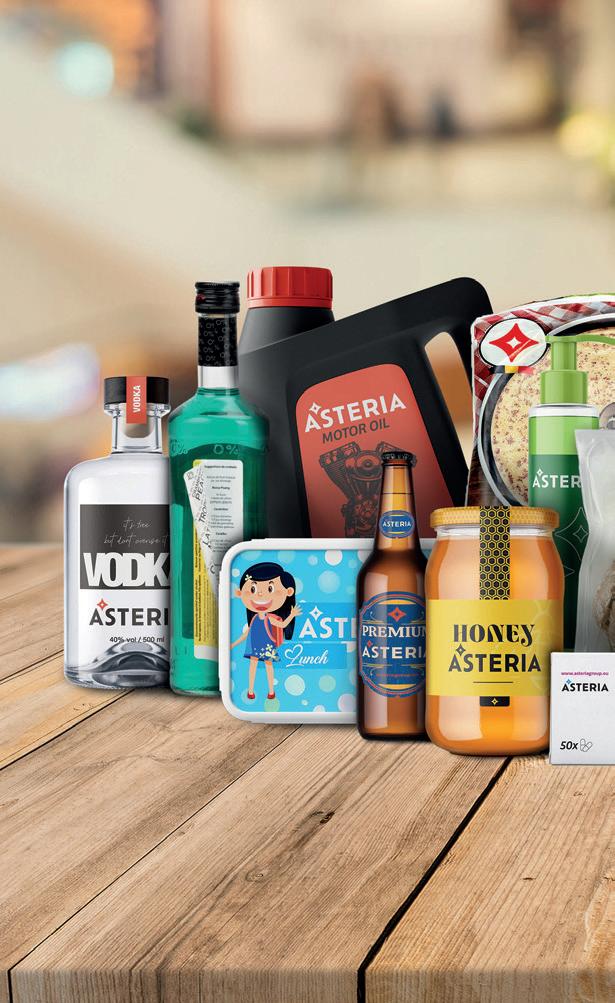
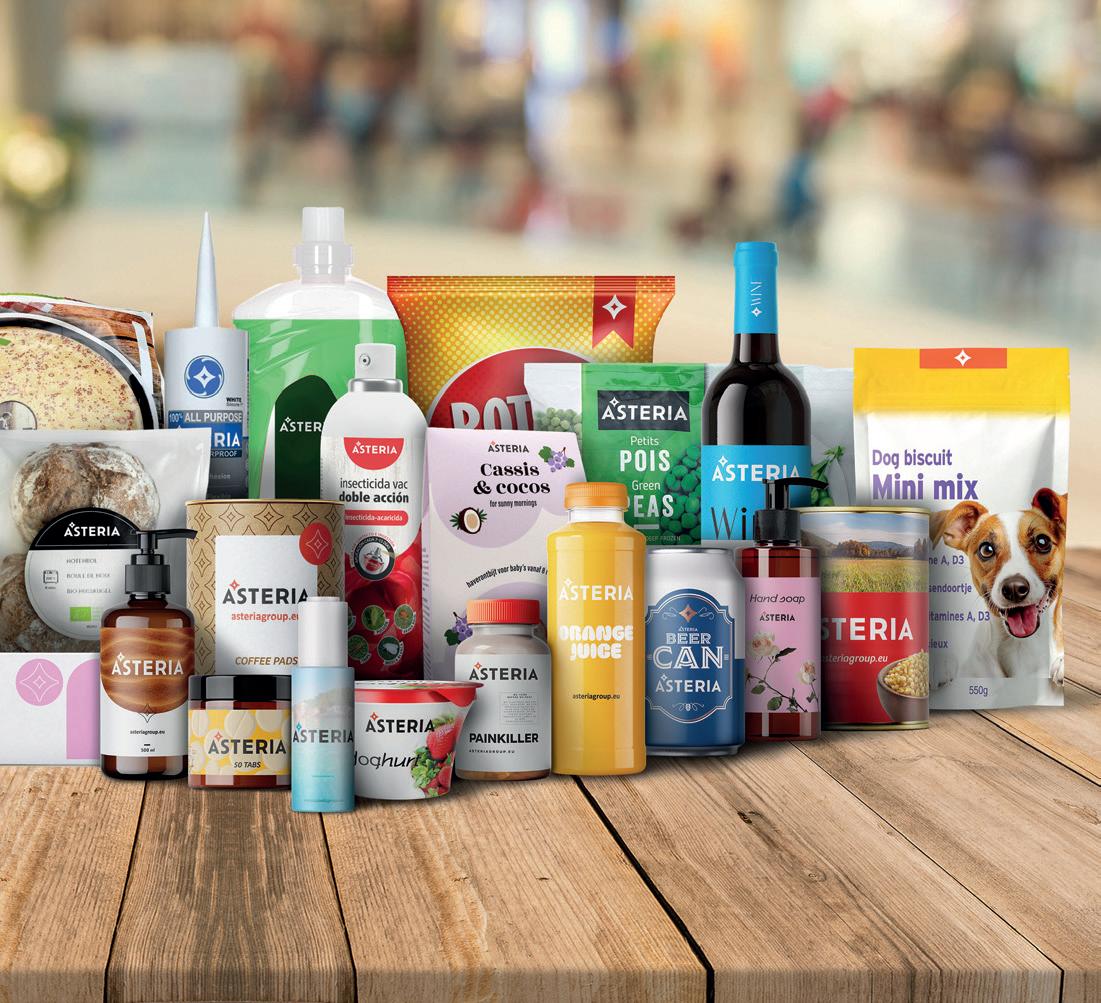

For pharmaceuticals, cosmetics, beverages and more, we convert paperboard into printed folded cartons that leave the press line cut, creased, folded and glued in one pass. A broad palette of group-wide printing and finishing techniques lets us add tactile or visual detail while keeping turn-round fast. Cartons can be paired with colour-matched labels from the same plant, ensuring consistent branding and a shorter supply chain.
For technical specifications, visit asteriagroup.eu
This table shows the share of revenues per product range (2024)



Asteria Sustainable Solutions (A.S.S.) offers concrete innovations that help our customers reduce their carbon footprint, minimise waste and enable recycling, all while maintaining high performance and shelf impact.




Each A.S.S. product family supports specific sustainability goals, with tested improvements in material efficiency, recyclability or circularity.

With Asteria Sustainable Solutions (A.S.S.), we are transforming the packaging and labelling industry by developing innovative, circular alternatives that balance environmental impact with commercial viability. The goal: reducing waste and improving recyclability. “By investing in sustainable materials and innovation, we help our customers future-proof their businesses”, says Alexis Dejonghe, Director Asteria Sustainable Solutions.

Why did Asteria Group launch the Asteria Sustainable Solutions category?
Alexis Dejonghe: “The idea emerged around 2020, when we first started exploring alternatives to traditional labelling and packaging. At that time, sustainability was still a niche topic in our industry. However, by 2022, we saw a shift: large multinational customers, particularly in the food and cosmetics industries, started demanding more sustainable packaging solutions. Instead of waiting, we took the lead.”
“We realised that sustainability would soon be as critical as price, quality, and service. Large companies and major retailers were already integrating sustainability into their purchasing decisions. If Asteria wanted to remain their preferred partner, we had to offer real, scalable solutions. That’s when we fully committed to Asteria Sustainable Solutions as a core part of our portfolio.”
“Asteria is also pioneering solutions that anticipate upcoming regulations like the EU Packaging and Packaging
Waste Regulation (PPWR). By 2030, all packaging must be fully recyclable, and 30% of plastic packaging must be from recycled content. We are already preparing our customers for these requirements.”
How do you ensure Asteria Sustainable Solutions maintain high quality and performance?
“Functionality is non-negotiable. A label or package must work just as well as its traditional counterpart. Otherwise, the solution is meaningless. We take a case-bycase approach. We test adhesion, durability, print quality, and recyclability to ensure that sustainable materials perform under real-world conditions. We work closely with brand owners and recyclers to develop materials that fit within the existing recycling infrastructure. For example, one of our key innovations is wash-off labels. These allow packaging labels to be easily removed during the recycling process, ensuring that plastic containers can be fully recycled without contamination.”
How do you balance sustainability with market competitiveness?
“Cost is always a challenge. Sustainable materials are often more expensive than traditional ones due to limited supply and higher production costs. However, we see a clear trend: as demand increases, prices will naturally decrease. At the same time, we must be realistic. The price point for the end consumer remains crucial, and we recognise that it is not Asteria’s role to dictate the market. Our job is to provide options to ensure that when customers are ready to make the switch, the solutions are there, scalable, and viable. We also help customers make smart choices by offering solutions that provide sustainability without significantly increasing costs. Sometimes, a small design change - such as using thinner materials or improving recyclability - can have a huge environmental impact without additional expense.”
“A big advantage is Asteria’s scale. With 35 sites across Europe, we can negotiate better pricing for sustainable materials and ensure that our solutions are available to as many customers as possible.”
Can you share an example of Asteria Sustainable Solutions in action?
“One of the best examples is our collaboration with a major European food and beverage brand. They were struggling to meet recyclability targets for their plastic packaging due to traditional label adhesives that contaminated recycling streams. We worked closely with
them to redesign their labels using our wash-off technology. The result? A 10% lower carbon footprint and full compliance with upcoming EU recyclability standards. This was of course an environmental win, but it also helped them enhance their brand reputation and improve consumer trust.”
How is Asteria preparing for future regulations?
“At Asteria,
we help brands make the transition without compromising on quality or performance”
Alexis Dejonghe

“The regulatory landscape is evolving rapidly. The PPWR is one of the most significant changes our industry has seen, and we are actively helping customers navigate it. We are investing in product innovation to ensure our materials are fully recyclable by 2030 and contain the required levels of recycled content. At the same time, we are collaborating with industry leaders, policymakers, and recyclers to stay ahead of regulatory developments. Another key focus is consumer education. Clear labelling and design for recycling will become even more critical as regulations tighten. We work with brands and retailers to ensure their packaging communicates proper disposal and recycling instructions to consumers.”
What drives you to lead Asteria Sustainable Solutions?
“I have been in the packaging industry for a long time, and I know how crucial packaging is— not just for branding and logistics, but also for preserving products and reducing food waste. At the same time, I see first-hand the impact that packaging waste has on our environment. My motivation is simple: I want to ensure that my children, and future generations, inherit a world where packaging is part of a circular system, not a waste problem. That’s why we are pushing Asteria beyond compliance and actively driving change in our industry. We have the expertise, the network, and the ambition to make a difference.”

Sustainability has already been on the company’s agenda for some time. In 2020, the first steps were made and in 2023 we officially launched the Asteria Sustainable Solutions (A.S.S.) programme.
In 2024 we started integrating sustainability into our overall company strategy. We reshaped our Executive Committee and appointed our Chief Sustainability Officer (CSO) who reports directly to the CEO.
A first ESG framework with priorities and focus areas was developed and will be refined in 2025, following the outcome of our double materiality assessment (see pages 22-23).
Environmental impact
Lowering the footprint
CO2 emission, energy & waste reduction
Sustainable product innovation
Sustainable procurement and sourcing
Sustainable distribution
Social impact
Engaging our people
Healthy & safe working environment
Equal treatment and opportunities for all employees
Talent growth & development
Governance & specific focus areas
Applying good business practices
Embedding sustainability in our organisation
Engaging with our value chain partners
Data security
Our role in the value chain
Positioned in between suppliers and often stringent (or economical) customer requirements, Asteria does not always have full control in choice of raw materials, printing methodology and/or finishing of the label. Moreover, we need to consider that the label (our product) is only a part of a complete packaging. Consequently, Asteria Group’s influence or impact on certain themes can be rather limited.
However, through innovation in sustainability and creation of ESG awareness, Asteria Group is ready to implement sustainable choices and requirements. Asteria wants to exert influence through ESG awareness and upstream and downstream advisory to enhance those sustainable choices by customers.
Commitment to SBTi with the aim to set near-term targets for Asteria
Operational excellence team further developed with specific projects on energy efficiency & waste reduction
Total of tonnes of CO2e Scope 1 & 2
PPWR regulation all directors and commercial teams are trained so we are ready as an organisation to provide customers with expert advice
& safety incidents
(compared to 67 reported in 2023)
Talent development kick-off of RISE Talent Accelerator Programme Gender diversity employees
Customer satisfaction Net Promoter Score (NPS):
Number of EcoVadis ratings in place within Asteria Group (14 out of 35 sites)
48 (industry benchmark: 32)

Approval of the business strategy, which includes the sustainability strategy.
Overall responsibility for the sustainability strategy as being a part of our business strategy. The Executive Committee has been defined as the Core Sustainability Team.
Report to the CEO directly, responsible for the implementation of the sustainability strategy on their sites. They are also responsible for that data collection towards the CSO.
Regional Experts
Sustainability Support / Advisory Team
The Regional Experts help align regional practices with corporate ESG goals through strategic advice on specific topics.
Benelux / Spain / France / Germany / Scandinavia + Estland / UK + Ireland
Technical Experts
Sustainability Support Team
Dedicated Chief Sustainability Officer (CSO) responsible for the development of the sustainability strategy.
Oversees the implementation of the sustainability strategy, follow-up of the defined roadmap and achievement of the set targets. The CSO is in close contact with the Managing Directors to follow up on the site-specific data collection.
The Technical Experts provide specialised expertise in areas such as quality, human resources, circularity and legal matters — ensuring that sustainability practices are strategically aligned, practically grounded, and effective throughout the organisation.
HR / Social / Product knowledge / Circularity / Waste / Quality / IT / Legal
In barely five years Asteria Group has grown into a network of 35 production sites operating in 10 European countries. Such rapid expansion inevitably raises the bar for consistent, verifiable sustainability performance, especially now that new frameworks like the CSRD, the EU Taxonomy and the forthcoming Packaging and Packaging Waste Regulation (PPWR) demand far deeper disclosure. To steer that agenda Asteria appointed Charlotte Van Uytsel as Chief Sustainability Officer in March 2024. She is to knit together local initiatives, build a robust data backbone and ensure that every strategic decision is taken with ESG considerations in view: “It’s up to me to make sure sustainability is on every table.”
Why is governance so important for Asteria’s sustainability work?
Charlotte Van Uytsel: “Our rapid international expansion works only if everyone operates in the same way. Governance supplies that framework: it sets clear responsibilities, reporting lines and shared standards. With those guidelines in place, the enthusiasm that exists in each plant becomes consistent, measurable progress for the whole group, rather than thirty-five separate good intentions.”
What governance structures have been put in place to oversee and ensure accountability for the different sustainability initiatives?
“We have built a three-layer structure. The Board of Directors approves the business strategy, which now embeds sustainability at its core. The Executive Committee, formally designated as our Core Sustainability
“Integration
remains the hardest nut to crack. Each acquisition arrives with its own culture, data formats and its own way of describing the same reality”
Charlotte Van Uytsel

Team, is responsible for delivery. I report directly to this body and present a progress update regularly. Finally, each site Managing Director owns implementation on the ground and supplies the data we need for group-level reporting. Where a topic is complex (CSRD, EU Taxonomy, PPWR) we create a dedicated working group that pools expertise from several countries so responsibility is shared but accountability remains clear.”
How are you embedding ESG in decisionmaking at Asteria Group, from operations to leadership?
“Embedding starts with visibility. ESG is firmly embedded in governance: it is a standing item at Executive Committee meetings, a key topic at our annual Asteria Management Days and Asteria Sales Days, and a regular point of review by the Board. Because the same metrics appear consistently at each governance level, operational teams, sales teams and senior leadership are working with one set of priorities instead of several disconnected lists.”
How do you engage colleagues in sustainability initiatives?
“The most effective way is to tap into local enthusiasm. Within our 35 entities we identify colleagues who already have an interest in topics such as energy efficiency or circularity and give them the mandate to lead on site. Because the ideas originate with people who understand their own plant, uptake is faster, and successes travel quickly across the network via internal knowledge-sharing.”
How have you been preparing Asteria for evolving sustainability reporting requirements, particularly CSRD compliance, EU Taxonomy and PPWR?
“My appointment as CSO in March 2024 put a single point of accountability in place. We then formed two
permanent working groups. The first focuses on CSRD and the EU Taxonomy: it brings together finance, legal and data experts to define methodologies and assure data quality. The second concentrates on PPWR. Using a train-the-trainer model, at least one specialist per country is now equipped to train sales teams so they can advise customers confidently on the new regulation.”
What challenges have you faced in implementing ESG initiatives, and how have you addressed them?
“Scale is the persistent challenge. In other words: integration remains the hardest nut to crack. Each acquisition arrives with its own culture, data formats and its own way of describing the same reality. Harmonising that diversity without slowing the business means striking a balance between central guidance and local flexibility. We tackle it by offering practical templates, on-call support and realistic timelines, making sure people understand that governance is there to help them, not to catch them out.”
What are your priorities for further developing the sustainability governance framework in the coming years?
“Our first priority is to form dedicated ESG workstreams for each of the priority areas identified in our double materiality assessment, assigning a small cross-functional team and measurable KPIs to every theme. The second priority is data: automating data collection, greatly reducing manual input and giving us the robust audit trail required for assured CSRD reporting. These two actions – clear ownership and seamless data – will let us move from compliance to watertight performance management.”


As an important part of the preparation for alignment and future compliance with the Corporate Sustainability Reporting Directive (CSRD), Asteria Group conducted an extensive double materiality assessment (DMA) in 2024, considering the guidelines of the newly adopted CSRD. The CSRD standardises how companies need to report on ESG for important or ‘material’ topics.
The DMA helped us to identify which topics are considered material, by assessing Impacts, Risk and Opportunities (IROs) linked to each of these topics.
Two perspectives are taken into account: impact materiality, which assesses the impact Asteria Group has on the environment and society with respect to a certain topic; financial materiality, which assesses the potential impact a topic might have in the future on Asteria Group’s financial success.
The IROs were identified based on insights gathered from desk research and stakeholder consultations. Each IRO was consecutively assessed considering the evaluation criteria mandated by CSRD.
In addition, the double materiality assessment provides insights into what Asteria Group’s key stakeholders consider important regarding sustainability. The resulting overview of IROs serves as a solid base to further develop Asteria Group’s sustainability agenda.
Overall, the double materiality process resulted in 4 topics and 7 sub-topics of material importance to Asteria Group, only from an impact materiality perspective. No financial materialities were identified due to the mini-
mal financial impact that Asteria Group currently has or could potentially incur from these topics.
After incorporating the discussed changes based on stakeholder views and interests, the following visual represents the final double materiality matrix with the material topics for Asteria Group. This list comprises all topics positioned above the bold blue line.
Environment
Social Governance
Entity-specific topics
1. CO2 emission reduction
2. Energy
3. Chemicals
4. Water consumption
5. Deforestation
6. Recycled content – outflow (recycling of products)
7. Recycled content – inflow (use of recycled content)
8. Waste reduction
9. Diversity & inclusion
10. Gender equality and equal pay for work of equal value
11. Measures against violence and harassment in the workplace
12. Talent development and retention
13. Human rights
14. Work-life balance
15. Health & safety
16. Corporate culture
17. Sustainable procurement & distribution
18. Protection of whistleblowers
19. Data security
20. Creation of ESG awareness
X-axis: Outside-in perspective: financial impact on Asteria Group
Y-axis: Inside-out perspective: environmental / social impact of Asteria Group

Definition of scope own operations and value chains
Identification of topics

Identification and assessment of Impacts, Risks & Opportunities (IROs)
Double materiality assessment & draft materiality matrix
Validation of material topics
Final materiality matrix
The value chains of all product groups start with the input of raw materials needed for the production of the labels, flexible packaging and folding cartons. Goods such as substrates, liquids, spare parts and equipment are purchased to provide and support the production of the following activities. For labels, the activities are: digital printing, flexo, fybrid, blank, offset, and flat screen printing. The activities performed on flexible packaging and folding cartons are limited to flexo, offset, and digital printing.
An additional stage in the value chain of all product groups includes the sales phase, which occurs prior to identifying the specific sector in which they will be utilised.
At the lifecycle end, all product groups could be disposed through landfill, combustion, or recycling. This depends on the region, the specific sector and/or the product type. Asteria Group has no impact on the method of disposal because the labels, packaging and cartons are part of a complete product.
Following our intention to comply with CSRD and the underlying European Sustainability Reporting Standards (ESRS), we have calibrated our sustainability framework according to the main categories used with ESRS, complemented with a category of entity-specific topics.
Below you can find the overview of ESG topics linked to ESRS standards, derived from the outcome of the recent double materiality assessment.

Measures
Talent
Human
Work-life
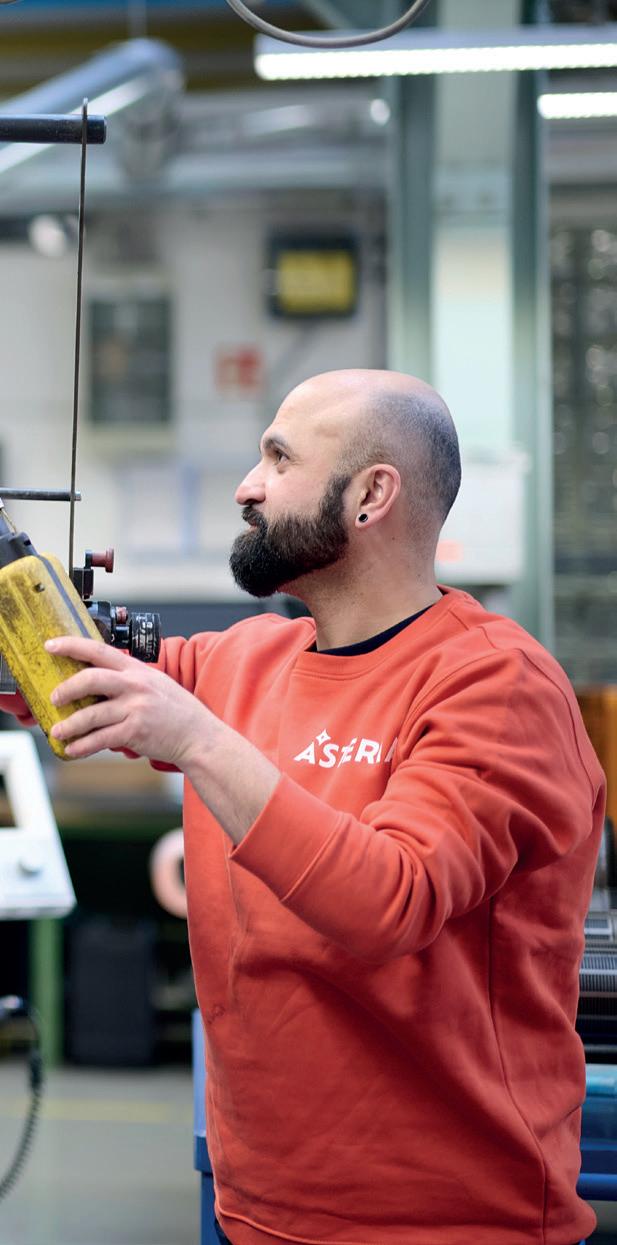
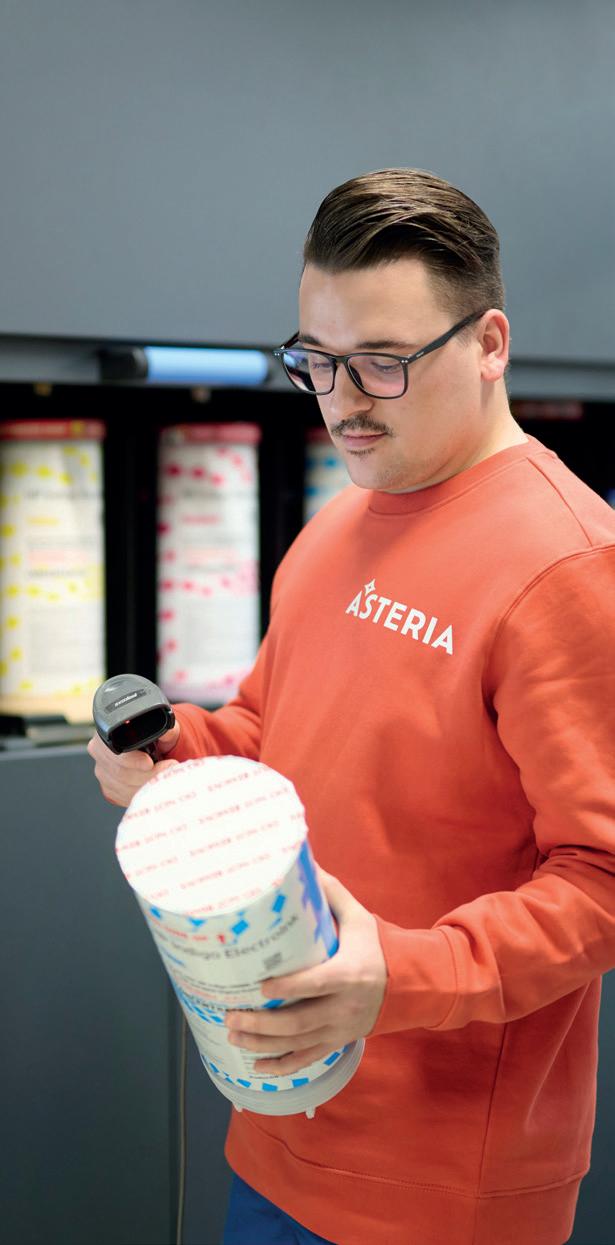

Printing and packaging inevitably carry an environmental footprint, yet Asteria is determined to shrink it. Guided by our motto “we think before we print”, we weigh every choice of material, energy use and waste stream before ink ever hits the substrate. Day in, day out, our 35 sites embed this mindset – moving to UV-LED curing, trialing circular recycling loops and scouting fresh innovations that push the bar higher. And because responsibility begins with compliance, we meet environmental regulations in every country where we operate. Yes, our impact is real, but so is our determination to be part of the solution.
Most of our carbon footprint stems from our core activities: printing and the materials that flow through the value chain.
Electricity is the main driver of scope 1 and 2 emissions, while substrates and raw materials dominate scope 3. As a converter, Asteria operates between suppliers and brand owners, with limited control but high exposure. Incoming regulation, such as the Packaging and Packaging Waste Regulation (PPWR), the EcoDesign Directive, and the revised CLP Regulation for chemical classification and labelling — raises the bar for compliance and reporting. At the same time, customers increasingly expect suppliers to deliver not just quality and speed, but also quantifiable climate impact. The opportunity lies in working closely with suppliers and offering lighter, recyclable label solutions, reducing emissions not just internally, but across the chain.
Our initial focus is on scope 1 and 2. A full data collection across 35 sites confirmed that electricity accounts for the vast majority of our energy use. We track this via ClimateCalc, applying the Intergraf sector methodology to ensure consistency and comparability across locations. These data form the basis for a group-wide CO₂ baseline and support the development of our reduction plan. Multiple sites are already acting: shifting from mercury to UV LED curing, switching to LED lighting, and improving production efficiency through local optimisation. Solar panel installations have been explored across the group, and operational excellence teams continue to identify ways to reduce energy consumption. Awareness training on energy use is in place at site level.
For scope 3, we are mapping emissions linked to raw material usage. Close collaboration with key suppliers and customers helps us align data and raise awareness about the carbon impact of design decisions, such as label size, substrate thickness or adhesive type.
We have also submitted a commitment to the Science Based Targets initiative (SBTi), setting the groundwork for validated reduction targets aligned with international climate goals.
By the end of 2024, Asteria had completed its first group-wide carbon inventory for scope 1 and 2. The energy analysis confirmed that electricity is the main contributor and highlighted the potential of increasing the share of certified green power. Several sites have already implemented improvements, from more efficient equipment to partial green electricity sourcing.
In 2025, we will develop a group-wide reduction plan, with interim targets for 2035 and concrete actions per site. We will also start tracking the ratio between grey and green electricity, with clear metrics to monitor progress. On scope 3, we will strengthen supplier data collection and launch life cycle assessments on selected product categories, laying the foundation for measurable reductions throughout the chain.

Circularity and waste reduction may not be our biggest environmental lever, but they remain a visible and strategic one. Across 35 sites, materials flow and waste handling vary, with different local rules adding complexity and compliance risks. At the same time, raw materials are becoming more valuable, and poor waste management increasingly comes at a cost. Reducing waste through smarter processes offers a double benefit: lower costs and a stronger reputation.
Our approach
In 2024, we started mapping the different waste streams at our sites. The group has a dedicated lead in place who coordinates the follow-up across the group. Waste management is a crucial part of our environmental policy, with a focus on operational efficiency and smart design.
Status in 2024 and outlook
Mapping of all the different waste streams has been an important first step.
It will allow us in 2025 to identify where our impact is the greatest, and which dedicated projects we will launch to optimise. Waste reduction will remain a core part of our ambition to increase efficiency.
Waste reduction: 5% reduction by 2026 10% reduction by 2030
Increase the percentage of company revenue in circular business (Asteria Sustainable Solutions) to: 10% by 2026 at least 33% by 2030


As part of its shift towards smarter, more responsible production, Asteria Group is one of the first in the labelling industry to implement UV-LED curing technology at scale. This innovation replaces traditional mercury-based lamps in flexographic printing with a safer, cleaner, and far more energy-efficient alternative without compromising print quality.
The environmental benefits are clear: UV-LED systems consume up to 40% less energy, generate no ozone, no use of mercury and drastically reduce maintenance and waste thanks to their long lifespan. “UV-LED technology is a smart step forward: it’s more efficient, safer, and fully aligned with our long-term sustainability strategy”, says COO Stefaan Gouwy. The transition did not happen overnight: each site required tailored adjustments to ink chemistry, machine settings, and cooling systems. Asteria’s in-house teams led the transformation, testing first in Belgium and later expanding across France, the Netherlands, Ireland, Spain, Germany and Finland. In some cases, multiple narrow presses were replaced by a single wide LED-enabled press, improving both productivity and energy use per printed metre.
While the end product remains unchanged, the switch strengthens Asteria’s position with customers seeking lower-carbon supply chains. “Most customers don’t notice the difference, which is excellent. But being able to say a label was printed using mercury-free, low-energy curing reinforces our credibility, especially with multinationals”, says Gouwy. The roll-out continues groupwide, forming part of Asteria’s broader ambition to embed sustainable thinking in every layer of production: efficient, safe and future-proof.
“UV-LED
technology is a smart step forward: it’s more efficient, safer, and fully aligned with our long-term sustainability strategy”
Stefaan Gouwy



ur 2,000 strong workforce is Asteria’s greatest asset, yet at the same time our biggest risk. Skilled printer experts are scarce, competition for talent is fierce, and losing expertise would slow both growth and innovation. That is why our social strategy centres on attracting, developing and retaining people in every one of our 35 sites.
At Asteria, we start with a common foundation of fairness, equality and respect. Local teams translate those values into practical actions: ergonomic aids that make shop-floor work accessible to more employees, targeted upskilling for printer experts, leadership coaching and cross-border career opportunities. Structured training keeps motivation high and opens pathways for advancement, while corporate guidelines ensure that diversity and equal pay are tracked consistently even amid ten different legal frameworks.
A single, one-size-fits-all policy is unrealistic in such a varied footprint, yet by stitching local best practice into group-wide standards we turn dispersed effort into measurable progress. Step by step, we are building a talent engine that secures today’s production and powers tomorrow’s growth.
Asteria is a very diverse and decentralised group that has grown rapidly, with 35 entities across Europe and a wide range of cultures, languages and legal systems. Our specific constellation brings strength, but also responsibility and challenges. Ensuring equal treatment and opportunities across our organisation requiresconsistency in how we approach diversity, gender equality, workplace safety and talent development.
Diversity and inclusion
Diversity is a visible topic in the labour market, on a site level, all our sites have a clear approach to the topic. However, a shared approach across the group allows us to even build more trust, further strengthen cohesion and creating an even more inclusive environment.
Gender equality and equal pay
Gender equality is met with growing expectations. Open communication and clear standards help us remain competitive as an employer.
Grievance mechanism
A policy is already in place at group-level, a clear grievance mechanism is available to all our employees. Ensuring a safe working environment is non-negotiable and essential to long-term talent retention.
Talent development and retention
Developing talent is crucial to our performance and continuity. A structured approach to learning and development, supported by training, dialogue and measurable goals, benefits retention and output alike.
Human rights
Ensuring a common standard within our group, is part of being a responsible employer and supplier in the European market.
Our approach
We fully comply with national labour laws in every country where we operate. These legal frameworks already define key protections, including working time, maternity and parental leave, and health and safety. But compliance alone is not enough. That is why we are stepping up to further align expectations more clearly at the group level across the topics that matter to us most.
Diversity and inclusion
Training to raise awareness and prepare the ground for more consistent practice is a priority. Initiatives such as Asteria Management Days and our yearly Asteria Sales Days bring managers together across sites to share perspectives, strengthen cohesion and foster a culture of openness.


Gender equality and equal pay
This is a strategic focus area for the group. While data are being gathered, early work is already under way to clarify where further action might be needed and how we can communicate more openly about our ambition and progress.

Grievance mechanism
Our corporate policy sets out expectations, but also implementation and awareness at local level remain a priority. Creating a safe andrespectful workplace depends on trust, clear reporting procedures, and visible follow-up.
Talent development and retention
All of our sites already invest in training for our people, our goal is to move towards a more structured, measurable approach. Training is a lever for performance and motivation, and increasingly a baseline expectation for new joiners.
Human rights
We ensure compliance with local legal standards and assess potential risks as part of our ongoing governance review.
Status in 2024 and outlook
In 2024, all entities met the minimum legal requirements in their country. Internal training on diversity and wellbeing has started, and platforms for exchange – such as our Asteria management days – are reinforcing a shared culture. In 2025, we will focus on harmonizing approaches across all sites, with initial priorities set on gender equality and talent development. Data collection will expand, and early indicators will help shape future action.
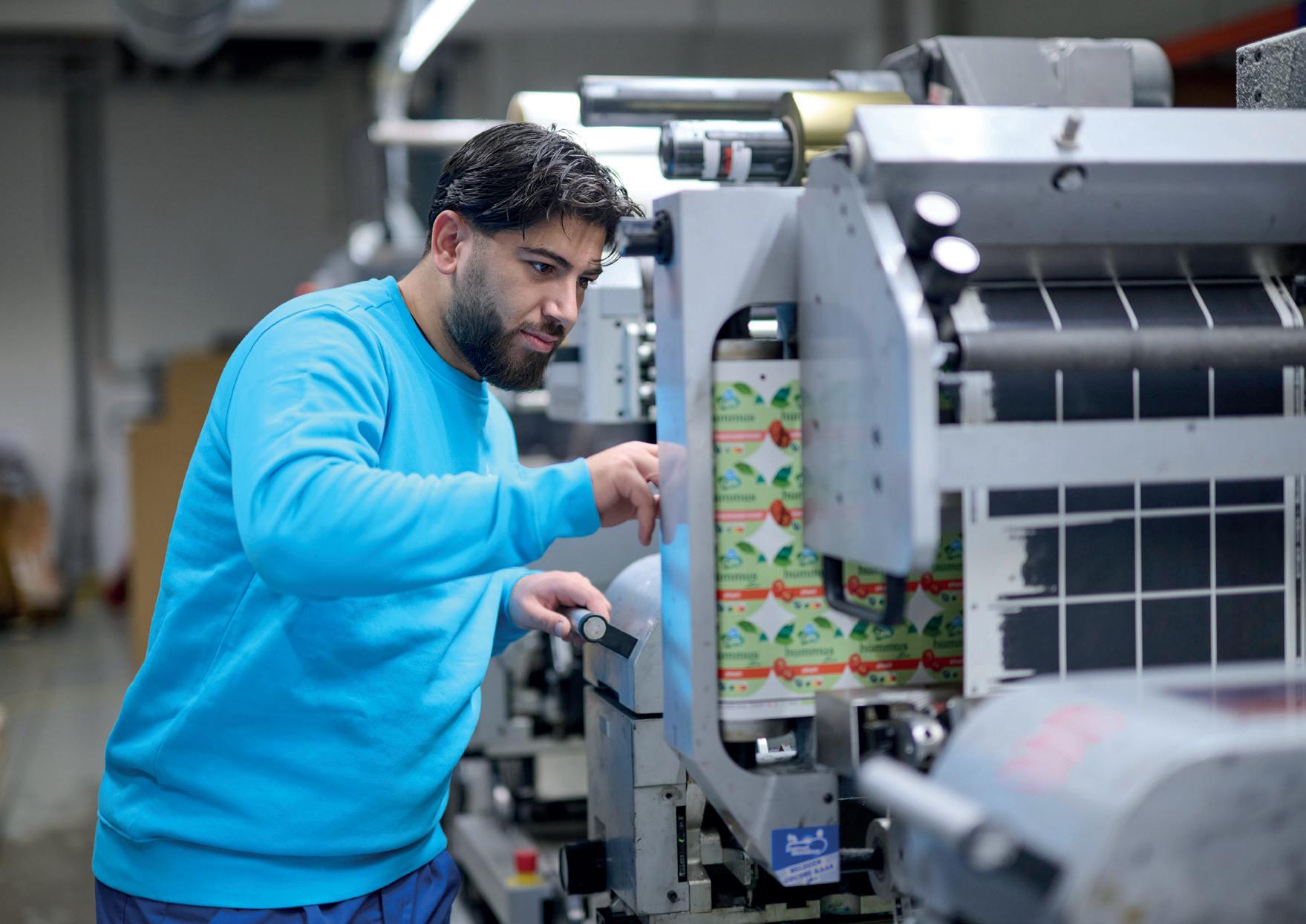
First and foremost, health and safety is on top of our mind at Asteria. Doing all our efforts to prevent incidents is our absolute priority. Training, awareness and clear procedures help minimise risks and support our ambition to aim for zero incidents across all sites.
Our approach
All Asteria sites follow national health and safety legislation. Site specific procedures reflect legal requirements and operational context. Training and awareness are a key part of our approach: we aim to reduce incidents by promoting prevention, applying clear standards, and engaging teams in safe working habits. A consistent programme supports implementation across the group and ensures that safety is embedded in day-today operations.
In 2024, all sites operated under national safety legislation. Group-wide incident data has been collected and will be further analysed to identify areas for improvement. In 2025, we will work to strengthen reporting, align awareness and training efforts across the group, and integrate health and safety more closely with our operational excellence roadmap, with the clear objective of reducing preventable incidents.



he RISE Talent Accelerator Programme reflects Asteria’s belief that developing people from within is essential to long-term success. By investing in high-potential employees, the group strengthens its leadership pipeline and builds resilience for the future. “RISE will help us stay competitive and innovative. It’s a commitment to shaping the next generation of leaders at Asteria”, says Beate Zipser, HR Director Asteria Germany and driving force behind the initiative.
What led to the creation of RISE?
Beate Zipser: “When I joined Asteria, I noticed how diverse and decentralised our operations were, especially in Germany. In Germany, we have nine entities, each with its own structure and size. Leadership succession had to be secured and we knew we couldn’t rely on external recruitment alone. In the German labour market, it’s tough to find strong candidates for management roles. That’s why I discussed the challenge with our CEO, Ives Declerck. We agreed the best solution was to grow our own talent. And so we launched RISE in 2024.”
How does RISE work?
“RISE is a two-year leadership journey, built specifically for Asteria. We start with a 3D leadership assessment to identify strengths and development areas. From there, we design individual growth plans. The programme combines online and in-person training, covering topics such as strategy, change, finance and communication. Every participant is paired with a mentor and takes part in real-life strategic projects that link to Asteria’s long-term goals. This isn’t an off-the-shelf solution, it’s tailored, practical and designed to create real impact.”
“RISE is a two-year leadership journey, built specifically for Asteria”
Beate Zipster

“The first group includes ten participants from Germany and the Netherlands. They range from late twenties to early fifties, with varied backgrounds and roles: from experienced managers to emerging leaders. What unites them is their potential and drive to grow. We also paid close attention to diversity. Our industry has long been quite a masculine one, so we actively aimed for a better balance, both in gender and in perspectives.”
What impact are you seeing so far?
“The engagement has been exceptional. Participants are motivated, committed and proactive. They take ownership of their growth. That energy spreads into their teams. We’ve also seen stronger collaboration across sites and countries. Before RISE, many managers worked in silos. Now, they exchange ideas, support each other, and start to shape a shared leadership culture, which is vital for a group like ours.”
What are the next steps for RISE?
“This is just the start. We’ll use the learnings from this first group to improve the programme and expand it across other countries. Our goal is to embed RISE in Asteria’s culture and roll it out across more countries.”

Good governance is the backbone of Asteria’s pan-European growth. In 2024 we reshaped our management team and appointed our CSO who reports directly to the CEO. By doing this, we embed ESG thinking into every strategic choice and accelerate progress across our 35 sites. Clear lines of authority, shared policies and transparent reporting now ensure that all parts of the group pursue the same goal: sustainable value creation built on trust and integrity.

Our expansion across ten countries demands solid governance. At Asteria that starts with an active Board of Directors, which sets strategy, approves major investments and oversees risk. Day-to-day control sits with the Executive Committee. Its members meet monthly to review performance and translate the Board’s objectives into clear, site-level targets. Every one of our 35 plants is led by a Managing Director who reports directly to the CEO, giving us a short, decisive chain of command that respects local expertise.
Until recently each entity maintained its own ethical rules. In 2024 we merged those documents into a single Asteria Group Code of Conduct (CoC). This CoC clarifies how we expect every colleague, anywhere in the group, to behave: act with integrity, respect people and the planet, compete fairly and be transparent about our business practices.
All managers were trained during the Asteria Management Days and Asteria Sales Days, and a further roll-out across all our sites will be organized during 2025. A confidential whistle-blowing channel, available online and by phone, allows staff and stakeholders to raise concerns without fear of reprisal. A dedicated team verifies that every site meets the same high standard of protection for reporters and follow-up for every case.
The CoC is backed by a comprehensive policy stack covering anti-bribery and corruption, export controls, GDPR, quality, health, safety and environmental man-
agement. Central templates set the baseline while site-specific procedures address local legal requirements. Internal auditors review compliance annually and corrective actions are tracked to completion.
External assurance matters just as much. Fourteen of our sites already hold EcoVadis medals, with further sites planned to be assessed in 2025. Many of our plants are certified to ISO 9001, ISO 14001, ISO 45001, BRCGS Packaging or FSC/PEFC. Membership of FINAT, FEBELGRA, the BPIF and other national trade bodies keeps us close to emerging regulation and best practice.
A priority in 2024 was gearing up for the Corporate Sustainability Reporting Directive (CSRD). Rather than a box-ticking exercise, the project has helped us standardise ESG data across 35 sites, weave common metrics into management routines and tighten the link between risk, strategy and sustainability. Treating the CSRD as a catalyst, we are creating a reporting framework that meets the rules and sharpens decision-making.
All these clear rules, transparent reporting and an empowered workforce give Asteria the license to operate sustainably, responsibly and right across Europe.
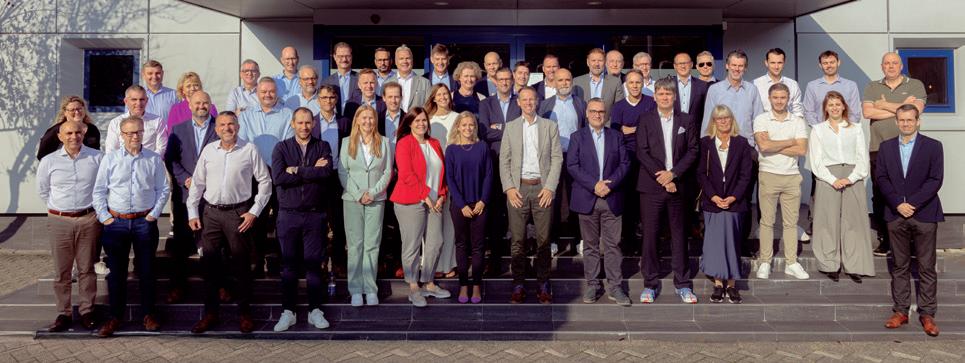

Our double materiality assessment does more than mapping the mandatory ESRS themes: it also surfaces issues that are uniquely important to our printing and packaging group operating in ten different countries. Two of those stand out for Asteria today.
Data security has become critical as we exchange vast files across 35 sites and multiple customer portals, while ESG awareness in the value chain is essential because our sustainability impact depends on close collaboration with both suppliers and brand-owner customers. These topics sit outside the ESRS catalogue, yet they shape our license to operate and our ability to drive change.
With 35 entities in 10 EU countries, Asteria operates in a complex, decentralised structure that generates and shares large volumes of data every day. That scale brings operational benefits, but also exposure. Safeguarding internal and customer data is essential to reduce security risks and maintain trust. In parallel, our position in the value chain – between material suppliers on one side and Fast-Moving Consumer Goods (FMCG) brands on the other – puts us in a unique role. We are not always in full control of design or material choice, but we do have a voice and influence. That influence depends on how well we understand regulations, how clearly we communicate ESG impacts, and how consistently we engage our stakeholders.
Our approach
Internally, data protection has been flagged as a top priority. With sensitive information flowing across borders and systems, we are strengthening controls and raising awareness at every level. From secure infrastructure to staff vigilance, we are embedding data security as a shared responsibility throughout the group.
On ESG, we continue to build awareness from the inside out. Site-level training is in place to help staff understand both our obligations and opportunities. Cross-site knowledge sharing, including via the Asteria Management Days and regular Asteria Sales Days, reinforces a common language and mindset across functions and countries. Externally, we are investing in close engagement with both suppliers and customers. Dedicated sustainability sessions help suppliers understand our expectations and explore alternatives, while

commercial teams guide clients through the regulatory landscape (notably the Packaging and Packaging Waste Regulation) and co-develop solutions under our Asteria Sustainable Solutions (A.S.S.) label. By supporting smarter design choices, we help customers reduce their footprint, which in turn enables us to meet shared targets.
In 2024, entity-wide ESG awareness grew visibly, with internal training, customer dialogues and supplier briefings gaining momentum. Data security remained high on the agenda, with measures in place to reduce risk and protect the group’s digital assets. The link be-
tween ESG and value creation became more tangible, especially where customer interest in A.S.S. translated into measurable uptake.
In 2025, we will expand our engagement: deepening customer conversations, tracking awareness metrics more clearly, and continuing to embed ESG across all operational levels. Targets such as the growth in A.S.S. adoption depend on collaboration, which makes awareness, and trust, non-negotiable.
Our ambition is to keep zero data security breaches on a yearly basis.
For Cargill, a global company providing food, ingredients and agricultural solutions, sustainability in packaging is becoming a core part of sourcing decisions. That includes labels and the data behind them. In close partnership with Asteria Group, the company is piloting new materials and preparing for upcoming EU regulations. Tarik-Daniel Attia, Category Lead for Industrial Packaging & Flexibles EMEA at Cargill, explains: “We’re testing now so we can scale when it matters. The better we understand what customers need, the faster we can respond with real solutions”, Tim Clockaerts, Chief Commercial Officer at Asteria adds.
How did your collaboration around sustainability begin?
Tarik-Daniel Attia: “The relationship with Asteria goes back many years, which makes things easier since we can rely on a partner that understands our complexity.
As we started our ESG journey at Cargill, we naturally turned to them for guidance on certifications, data and innovation.”
Tim Clockaerts: “We appreciated that early openness. When we were shaping our ESG strategy at Asteria, Cargill was one of the partners we reached out to. Their expectations helped create our own roadmap.”
“We want to be the partner of choice for customers who value sustainability”
Tim

What role does sustainability play in your daily operations?
Tarik-Daniel Attia: “I lead procurement for industrial packaging and flexibles, labels included. ESG is an integral part of our supplier assessments and decision-making. We use internal evaluations as well as third-party ratings, with EcoVadis as our main external benchmark. We also have a close look at our suppliers’ material impact, CO₂ footprint and supply chain design. The biggest challenge is always data: collecting, structuring and using it in a meaningful way.”
Which solutions does Asteria offer Cargill today?
Tim Clockaerts: “Cargill sources both self-adhesive and wet-glue labels from us. Wet-glue options are more constrained because of technical requirements, but for self-adhesive, we offer alternatives under our Asteria Sustainable Solutions label. These include e.g. thinner materials and wash-off labels that support recyclability. With Cargill, we’re currently testing wash-off labels, one of the most requested solutions in our sustainable range.”
What challenges do you face when moving to sustainable labels?
Tarik-Daniel Attia: “Labels weren’t initially high on Cargill’s risk radar. But evolving regulations like the Packaging and Packaging Waste Regulation (PPWR) mean we need to be ready. The lack of clear design-for-recycling
guidelines makes it difficult to take final decisions, but thanks to Asteria’s guidance, we’ve begun testing options like washable labels. It’s about being prepared now, so we can scale fast when clarity arrives.”
Is there market pressure around pricing for sustainable materials?
Tim Clockaerts: “Absolutely. Most customers want more sustainable solutions at an affordable price. So, we look for options that add value while keeping costs manageable. We’d like to believe that prices will drop on some materials as they reach a critical volume threshold. That could be true for thinner and/or recycled content labels, the customers will ultimately decide which materials fits their sustainability goals best.”
Tarik-Daniel Attia: “From our side, we’re not aiming to be front-runners at any cost. But we want to be ready. That’s why we test, we learn, and we prepare. In B2B, especially, the push for change often comes from the customers, think of a major retailer asking for specific label formats. It’s crucial that we can respond quickly when that moment arrives.”
How do you measure impact and progress?
Tarik-Daniel Attia: “We track KPIs internally and we’re aligning more closely with suppliers like Asteria on shared metrics. Scope 3 emissions are now in focus, and that means we need partners who can provide data, not just claims.”
“We can rely on a partner that understands our complexity”
Tarik-Daniel Attia

Tim Clockaerts: “That’s also why at Asteria, we’ve committed to the Science Based Targets initiative (SBTi). We’re aligning our operations with 2030 emissions targets and investing in energy efficiency, from LED curing to machine upgrades. More than being compliant, we want to be the partner of choice for customers who value sustainability.”
What are your next steps together?
Tarik-Daniel Attia: “For Cargill, it’s about finalising the pilot with washable labels, evaluating their fit, and scaling where it makes sense. At the same time, we’ll keep exploring efficiency gains in logistics and delivery.”
Tim Clockaerts: “On our side, we’re building momentum through readiness. By working proactively with companies like Cargill, that don’t just wait but test and learn, we’re in a better position to support the wider shift.”

First edition of the Sustainability Report 2024 in 2025 1 January 2024 - 31 December 2024
Publication management
Charlotte Van Uytsel
Sustainability advice and support
Moore Belgium (moore.be)
Counsel, storytelling, editing & design 3rd Rock Collective (3rdrockcollective.com)
Questions or feedback
Charlotte Van Uytsel - mob. +32 488 81 80 60
More information asteriagroup.eu